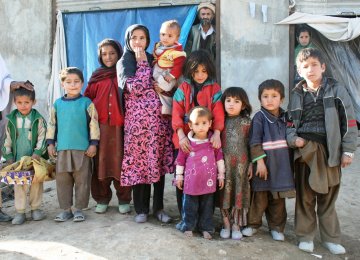Over 20 years ago Hamideh, a 47-year-old Iranian woman, married an Afghan refugee. She has two daughters and two sons. The girls are 10 and 11 years and the boys, 18 and 20. Over the years the children have faced several problems, including a crisis of identity.
They are not alone; at present, at least more than 30,000 Iranian-Afghan couples suffer the same fate (this is only the number of registered marriages; the actual number is far more).
According to official figures, at present, 32,000 children in the country don’t have birth certificates as their Iranian mothers are married to illegal immigrants, and therefore “their identity is anonymous,” Khabaronline News Agency reported.
“Our marriage has been registered legally in the country; however our children don’t have ID cards. They believe they’re Iranians, but nobody accepts this,” says Hamideh who lives with her family in Khak-Sefid neighborhood, in northeastern part of Tehran Pars, Tehran District 4.
“My parents were initially opposed to our marriage but later gave in. My husband is a good man. I hope the authorities will do something to fix our problems,” she says.
A legal amendment to the nationality law passed in 2006 allowed children born in Iran to Iranian mothers to apply for citizenship on reaching the age of 18, under certain conditions, including registration of parents’ marriage with the competent state authority, and if they have been living in the country for five consecutive years.
“But the law is not being implemented. My children don’t have Iranian ID cards. They registered in schools by showing their passports,” Hamideh said. The only legal documents her children have are their passports issued by the Afghan Embassy in Tehran.
“Although my sons did well in school, one is working as a deliveryman and the other as a barber. Their wages are low as they are not officially employed.”
While her husband has worked and lived in Iran for 28 years he still doesn’t have any stability in life.
Several years ago the family moved to Afghanistan and stayed there for about three years. “But it was hard for me and my children to live there given the unending instability and insecurity. So we decided to return to Iran.”
Every year, many women like Hamideh migrate to Afghanistan and are forced to live in poverty and wretched conditions. According to official figures, currently over 400 Iranian women married to Afghan men live in the war-ravaged country’s Herat Province.
Social Problems
At least 26,000 marriages of Iranian women and Afghan men in Iran are said to be unregistered, leaving them in a legal limbo.
Children born from these marriages face many social hurdles. Without Iranian birth certificate, free education in local schools and right to employment, subsidy and social welfare benefits like insurance are all denied. They also do not have the right to inherit property.
Unofficial statistics indicate the birth of 22,000 children without “clearly defined identity” in Mashhad, capital of Khorasan Razavi Province.
There is a huge settlement of refugees in the holy city where the shrine of the 8th Shia Imam Reza (AS) is located. Around 4,000 applications for citizenship by children of Iranian mothers and non-Iranian fathers have so far been filed at the provincial Bureau for Aliens and Foreign Immigrants Affairs (BAFIA).
Millions of Afghans live and work in Iran, legally and illegally, despite the efforts of the government and the UNHCR, the UN refugee agency, to repatriate them.
Most of the Afghan men took refuge in Iran either after the Soviet invasion and occupation of Afghanistan in 1979, or following the Afghan civil war in the 1990s and the US-led invasion in 2001. During these decades Iran was host to nearly four million Afghan refugees. At present there are 3 million Afghan refugees of whom only 1 million have legal refugee status.





